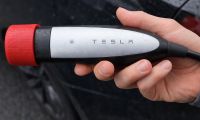Monday’s email inbox came with a “most popular postings of the week,” from our friends at CivicX.com. Along with the usual question and answer love fest, came a pictorial reminder from a new member in Puerto Rico. Carlitos PR, (Carlos) an avid car-club track racer, has seat time in a BMW E30, a Porsche Boxter GTS, and has transitioned into the seat of a fresh off the boat 2017 Honda Civic Type-R. Congratulations!
Scuffed right front tire, and intermittent overheating
Carlos praises the overall handling and braking performance of Honda’s latest and greatest performance Civic. However, in his day at the track, with temperatures ranging into the high 90F range, with humidity to match, Carlos encountered a bit of intermittent overheating while pushing a factory specified 2017 Honda Civic Type-R to its red-line, while driving under aggressive track conditions. Could be Carlos!
Looking to Carlos’s photo, he found the O.E.M. Type-R Tire’s track limit
Sure, we’ve all burned off a tire or two at track day. This post is a great reminder that while 2017 Honda Type-R is may be race-ready by street standards, serious track time will require a mild upgrade or two, including a track-tire-compound upgrade, and possible race-ready intake and cooling components.
Depending on the driver’s capability and track conditions, any car, regardless of factory suspension settings, disk and brake caliper size, and tire compound, will experience accelerated tire and part degradation. At the end of the day, Carlos’s Civic Type-R performed as anticipated by the new owner. Enjoy!












